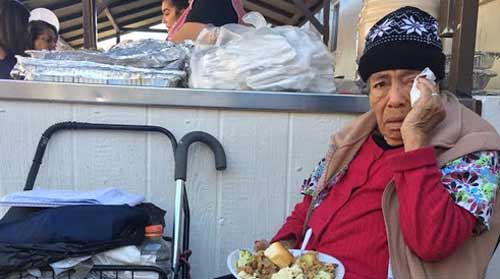A Poor Christmas for Latino Elders on LA Streets

*Don’t mean to dampen your holiday mood, but this is important and not only in LA: “Twelve percent of the 7.1 million people the Regional Food Bank serves annually, more than 850,000 are 65 and older. Of those, reflecting the county’s demographics, nearly two-thirds (63 percent) are Latino.” VL
By Francisco Castro, New America Media (7 minute read) 
First article in a series.
LOS ANGELES–Walking slowly–helped by a cane and pushing a shopping cart with all her belongings–Maria Luisa Ayala reaches the food distribution table at the Olvera Street church in the heart of Los Angeles.
She gets her plate, sits on a chair and starts eating slowly.
“This food is heaven sent,” she said trying to hold off tears.
Ayala is 84 and homeless. For the past three years, her home has been a stretch of sidewalk near the corner of Washington Blvd. and San Pedro St., just on the outskirts of Downtown. LA’s skyscrapers can be seen in the distance from there, but she’s at the bottom of Lalaland’s human pile.
Life in old age has turned sour for this elder, covered in several layers of sweaters and a beanie to keep the stinging cold this afternoon.
“I don’t have any family. I live by myself,” said the native of Jalisco, Mexico, who’s been living in the United States for 35 years.
Hunger Pangs
Living on the street, she’s learned to be vigilant all the time to keep herself safe. She also knows the pangs of hunger on an empty stomach.
It’s a shared feeling with thousands of others in this metropolis.
One-in-seven people–about 1.4 million in Los Angeles Count–experiences food insecurity, according to the Los Angeles Regional Food Bank. And one-in-six of them of do not know where their next meal is coming from.
Hunger affects old and young alike, but seniors are especially in peril.
Twelve percent of the 7.1 million people the Regional Food Bank serves annually, more than 850,000 are 65 and older. Of those, reflecting the county’s demographics, nearly two-thirds (63 percent) are Latino.
“Despite the improved economy, Los Angeles County has more people experiencing food insecurity than any other county in the United States,” said Michael Flood, president and chief executive officer of the Los Angeles Regional Food Bank.
Poverty and Hispanic Seniors
Studies by UCLA’s Stephen P. Wallace, PhD, show that the number of older adults is expected to double in 30 years. But the fastest growth will be in elders of color.
Wallace, who directs the national coordinating center for the federally-funded Resource Centers for Minority Aging Research, said Latinos, especially, will make up 15.4 percent of adults by 2050.
But many of them will lack the funds to live a dignified old age.
Among those ages 65 or older living under the federal poverty line, 20.1 percent are Latino, said Wallace. That means these individuals are trying to get on $11,880 annually. Another 31.6 percent are just over that edge. So more than half of older Hispanics qualify as poor and near poor.
Major contributors to high levels of Latino elders’ poverty are low-paying jobs, lack of employment and social benefits due to immigration status, and the high cost of housing, noted Wallace, who presented his findings at the Gerontological Society of America annual conference last month in New Orleans.

If you are undocumented, you don’t get Social Security, Medicare or any other social benefit–although many still pay taxes toward those programs.
That makes it difficult to pay for things, especially a roof over your head, an already heavy cost burden for most.
“Housing is the biggest expenditure” for older adults in Los Angeles, said Wallace, who also chairs of the Department of Community Health Sciences at UCLA Fielding School of Public Health.
Last year, the average monthly rent for a one-bedroom apartment in Los Angeles was $1,154 — one of the highest levels in the country — and qualifying for Section 8 subsidized rental vouchers is nearly impossible, given years-long waiting list.
With much of their income going to housing, little is left for anything else.
Many must decide whether to pay their rent, pay for medicines or put food on their table.
That is detrimental to their overall wellbeing. “It’s bad for their physical health and brings psychological ailments,” Wallace said.
Dependent on the Help of Others
It’s the middle of a Thursday afternoon and the Calvary Baptist Church’s Family Life Center in Pacoima, an area of the San Fernando Valley, is a beehive of activity.
There are people downloading boxes full of vegetables, fruits, yogurt and other food items from a truck and putting them on tables arranged in a semi-circle. Several more people — many of them older adults — are just on the other side of the fence carrying bags and eagerly looking on.
Every Thursday starting at 2 p.m., the Center distributes food to people in need. There’s no questions asked about immigration status, income level or any other personal information.
Older adults get to go first on the line, seniors such as Rosa Orellana, 76.
After arriving from El Salvador over a decade ago to help raise one of her daughter’s children, Orellana overstayed her tourist visa, so she does not receive any benefits. All she has is Emergency Medi-Cal, for basic health needs.
Orellana says times are tough for the entire family, and they often have to resort to borrowing money to pay the rent and utilities.
Whatever food she gets at the food bank helps them all make ends meet. “This is a big help because we don’t have to go and buy it,” Orellana said. She added that her daughter “doesn’t want me to come, but I see the need in the house.”
Guillermo Carmona can count himself among the lucky ones here.
The 63-year-old from Guadalajara, Mexico, he retired after working for a factory that moved to Mexico over 20 years ago. His only income is what he and his wife receive from Social Security: just over $1,300 a month, about average for seniors in the U.S.
But his mortgage is over $1,000 a month. He also must pay for utilities and other needs, which leaves them with little to no money left. His youngest son still lives with them.
Carmona comes to the food distribution center every week. He also visits a similar food bank another day of the week.

“Life is so expensive. The money we get is not enough,” Carmona said. “If it wasn’t for these places, we wouldn’t make it.”
Bulah Anderson, head of the food distribution program, said that’s the reason why they give out the food.
“This helps them keep money in their pockets. Maybe it’s $5, but they can use it for medicines or to pay bills,” Anderson said.
Also in line is Emma Zepeda. Every week, the 63-year-old El Salvador native visits three food banks in this area.
Couple Lost Their Home
Zepeda lives with her husband, Juan Bautista, 67, the sole money earner. At his age, Bautista still heads to a Home Depot in search of jobs every day. He’s a day laborer and employment is not secure. He may get hired for fixing a lock or other small jobs, but employers usually prefer younger workers.
Still, whatever he earns he takes home, while they still have it.
Zepeda worked for a church for 10 years, but she’s not getting a retirement pension or other benefits. Her husband’s immigration status means he doesn’t get anything either.
“We don’t qualify for anything. I head out to these places to get food so we don’t die from hunger,” she said.
But while at least the food is taking care of, the family now faces an uncertain future.
They could no longer pay the mortgage and they lost their home. The bank already sold it and the new owner has been coming over to ask them to leave.
Zepeda doesn’t know whether she will have a roof over her head this Christmas.
This article was originally published in New America Media.
Francisco Castro, city editor of La Opinión in Los Angeles, wrote this article as the first in a series he developed with support from the Journalists in Aging Fellowships, a program of New America Media and the Gerontological Society of America, sponsored by the Silver Century Foundation.
[Photos courtesy of New America Media]
